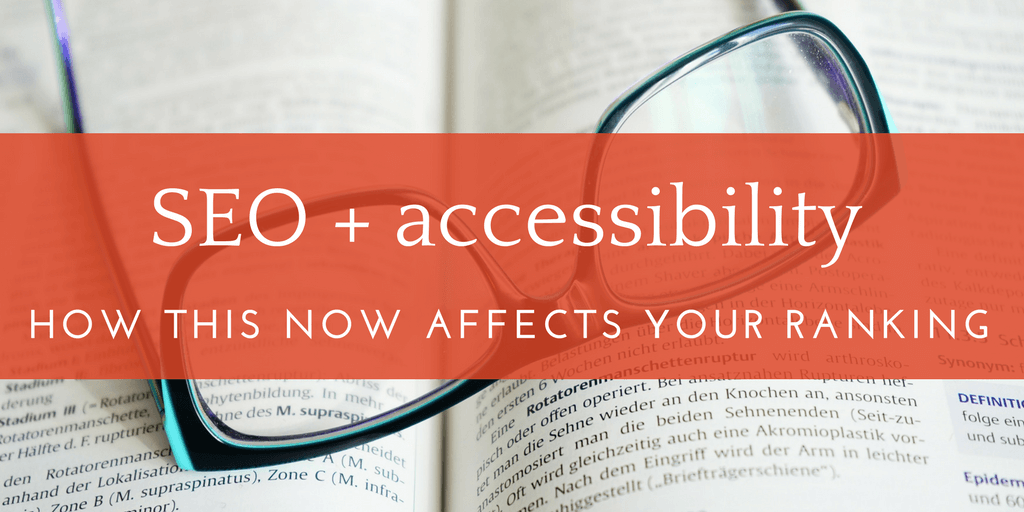Looking for an SEO lift? Start with Web Accessibility
Jerod Greenisen | March 2019
As a marketer, it goes without saying that it can be difficult to gauge where your SEO is at and what to do to improve it. Whether you’re creating a new website or looking to give your current site a bump in performance, I’d like to point out a new focal point from which to start: web accessibility.
 We already know SEO best practices need to be top-of-mind in order to increase you business metrics. However, many of us don’t yet start this within the framework of web accessibility. By doing so, you’ll not only have a more focused approach, but you’ll also be meeting the needs of more of your users.
We already know SEO best practices need to be top-of-mind in order to increase you business metrics. However, many of us don’t yet start this within the framework of web accessibility. By doing so, you’ll not only have a more focused approach, but you’ll also be meeting the needs of more of your users.
What is ‘web accessibility’?
Web accessibility generally means complying with Web Content Accessibility Guidelines (WCAG 2.0) and the recent update from United States Access Board called Section 508. View a full list of all the requirements at W3.org.
Section 508 makes it clear that any business accepting public dollars needs to be compliant with accessibility standards. You can view the Section 508 announcement at USAB’s website. This is a major shift for businesses and what it means to do business online for everyone. Know that the implications of web accessibility compliance are real and they are here to stay. Moreover, businesses that ignore them are finding themselves in lawsuits. Let’s avoid that for you, shall we? Read the points below to understand your next steps.
What is an example of how web accessibility can affect my SEO?
The web accessibility standards are in place to ensure that users like Jessie and others are able to use the internet just as well as anyone else – no matter what their abilities are. Search engines now work to help Jessie digest digital information by scanning pages for information. To better understand what this looks like, watch as Jessie uses similar tools. Note that Google does not recognize images or most other aesthetic design elements, but instead, it crawls code line-by-line to gather information. If not marked up with proper descriptive code, your site is not considered as accessible and your SEO will continue to take a hit.
The best ways to boost your SEO while meeting Web Accessibility standards.
1. Use descriptive keywords and legitimate titles.
Google and users who use a screen reader will jump to your title first. Makes sense right? Well, if the header does not conceptually match the context of that page, it can be disorienting for users. Google responds by negatively indexing this page if it finds your titles do not match the content, or are intentionally misleading.
Make sure that your titles make sense across the environment that they appear in and that your posts are featuring descriptive keywords that reinforce that title. That way you’ll likely get a nice boost in SEO.
2. Establish an unbreakable style guide for HTML markup and branding.
As I mentioned above, the tools that help users access information on the internet work just like Google’s assessment tools. In order to communicate clearly with users, these tools need proper HTML markup.
When building a new website or auditing an existing one, make sure that your pages use the <H1>, <H2>, etc. tags according to best practices. This means making it clear in your style guide what those look like. Using styling to replicate a visual is not the same as being consistent with code and branding.
3. Give photos a description.
Google can’t see your photos and neither can those with vision loss. Recognize this as you add new visuals and include a description that would make sense to your user. If done well, the screen reader can tell the user what the photo is regarding. This is super important if you’ll be placing text on photos to communicate an idea like with a CTA.
Now what?
These are just a few ways you can align your SEO efforts with web accessibility. Get the full picture by using our resource center (click the button below!). We hope that as you consider your position in Google’s search results, you’ll use the most efficient methods to get there. Using web accessibility as a framework for good SEO is a great start. Stay tuned from more advanced SEO and web accessibility tips!
 We already know SEO best practices need to be top-of-mind in order to increase you business metrics. However, many of us don’t yet start this within the framework of web accessibility. By doing so, you’ll not only have a more focused approach, but you’ll also be meeting the needs of more of your users.
We already know SEO best practices need to be top-of-mind in order to increase you business metrics. However, many of us don’t yet start this within the framework of web accessibility. By doing so, you’ll not only have a more focused approach, but you’ll also be meeting the needs of more of your users.
